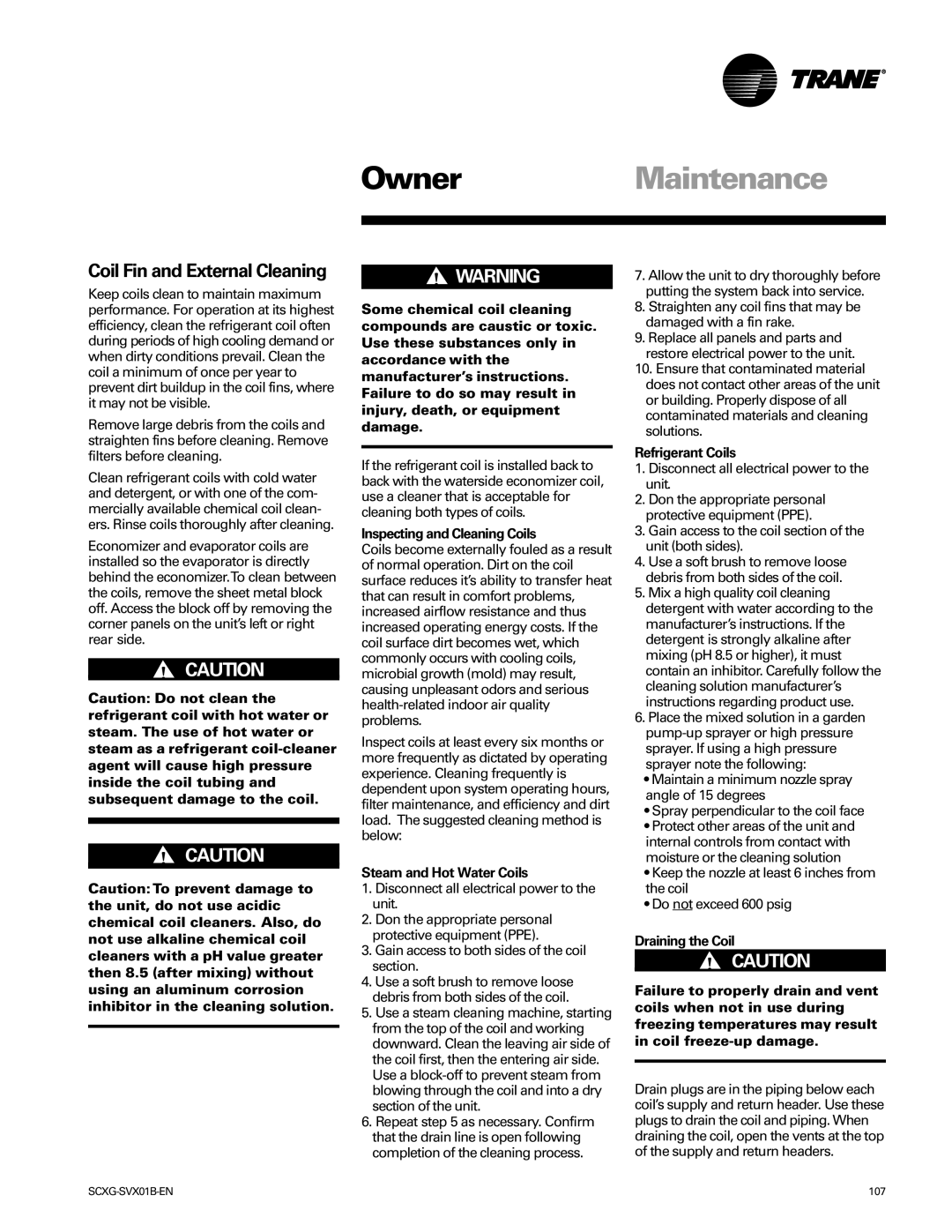
Owner Maintenance
Coil Fin and External Cleaning
Keep coils clean to maintain maximum performance. For operation at its highest efficiency, clean the refrigerant coil often during periods of high cooling demand or when dirty conditions prevail. Clean the coil a minimum of once per year to prevent dirt buildup in the coil fins, where it may not be visible.
Remove large debris from the coils and straighten fins before cleaning. Remove filters before cleaning.
Clean refrigerant coils with cold water and detergent, or with one of the com- mercially available chemical coil clean- ers. Rinse coils thoroughly after cleaning.
Economizer and evaporator coils are installed so the evaporator is directly behind the economizer.To clean between the coils, remove the sheet metal block off. Access the block off by removing the corner panels on the unit’s left or right rear side.
!CAUTION
Caution: Do not clean the refrigerant coil with hot water or steam. The use of hot water or steam as a refrigerant
!CAUTION
Caution: To prevent damage to the unit, do not use acidic chemical coil cleaners. Also, do not use alkaline chemical coil cleaners with a pH value greater then 8.5 (after mixing) without using an aluminum corrosion inhibitor in the cleaning solution.
!WARNING
Some chemical coil cleaning compounds are caustic or toxic. Use these substances only in accordance with the manufacturer’s instructions. Failure to do so may result in injury, death, or equipment damage.
If the refrigerant coil is installed back to back with the waterside economizer coil, use a cleaner that is acceptable for cleaning both types of coils.
Inspecting and Cleaning Coils
Coils become externally fouled as a result of normal operation. Dirt on the coil surface reduces it’s ability to transfer heat that can result in comfort problems, increased airflow resistance and thus increased operating energy costs. If the coil surface dirt becomes wet, which commonly occurs with cooling coils, microbial growth (mold) may result, causing unpleasant odors and serious
Inspect coils at least every six months or more frequently as dictated by operating experience. Cleaning frequently is dependent upon system operating hours, filter maintenance, and efficiency and dirt load. The suggested cleaning method is below:
Steam and Hot Water Coils
1.Disconnect all electrical power to the unit.
2.Don the appropriate personal protective equipment (PPE).
3.Gain access to both sides of the coil section.
4.Use a soft brush to remove loose debris from both sides of the coil.
5.Use a steam cleaning machine, starting from the top of the coil and working downward. Clean the leaving air side of the coil first, then the entering air side. Use a
6.Repeat step 5 as necessary. Confirm that the drain line is open following completion of the cleaning process.
7.Allow the unit to dry thoroughly before putting the system back into service.
8.Straighten any coil fins that may be damaged with a fin rake.
9.Replace all panels and parts and restore electrical power to the unit.
10.Ensure that contaminated material does not contact other areas of the unit or building. Properly dispose of all contaminated materials and cleaning solutions.
Refrigerant Coils
1.Disconnect all electrical power to the unit.
2.Don the appropriate personal protective equipment (PPE).
3.Gain access to the coil section of the unit (both sides).
4.Use a soft brush to remove loose debris from both sides of the coil.
5.Mix a high quality coil cleaning detergent with water according to the manufacturer’s instructions. If the detergent is strongly alkaline after mixing (pH 8.5 or higher), it must contain an inhibitor. Carefully follow the cleaning solution manufacturer’s instructions regarding product use.
6.Place the mixed solution in a garden
•Maintain a minimum nozzle spray angle of 15 degrees
•Spray perpendicular to the coil face
•Protect other areas of the unit and internal controls from contact with moisture or the cleaning solution
•Keep the nozzle at least 6 inches from the coil
•Do not exceed 600 psig
Draining the Coil
!CAUTION
Failure to properly drain and vent coils when not in use during freezing temperatures may result in coil
Drain plugs are in the piping below each coil’s supply and return header. Use these plugs to drain the coil and piping. When draining the coil, open the vents at the top of the supply and return headers.
107 |
